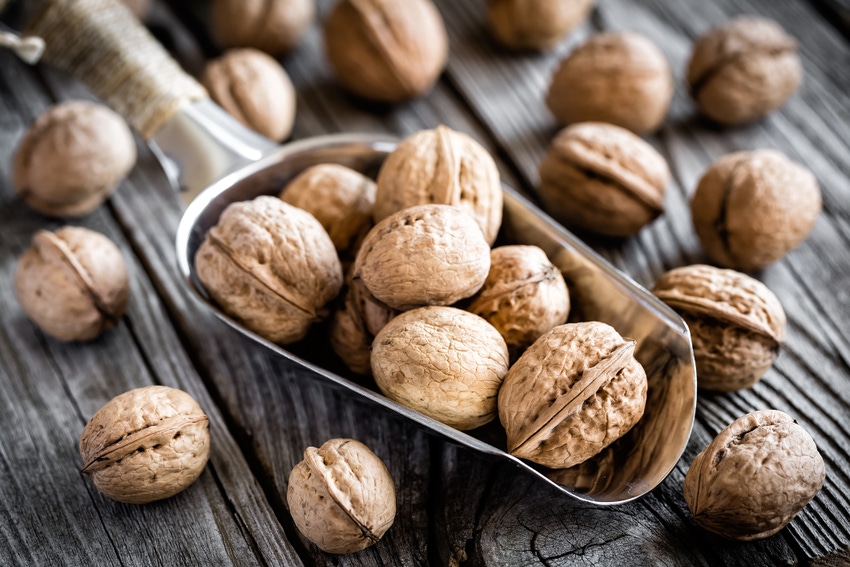October 19, 2016

This is all about a paradox.
Due to superior resistance to Phytophthora crown and root rot, increased vigor, and more adaptability to marginal walnut soils, walnut trees on Paradox rootstock are the preferences of most California walnut growers, even though the rootstock is highly susceptible for the bacteria disease crown gall.
There are ways to treat for the disease caused by Agrobacterium tumefaciens. And the most recent developments in this include nipping it in the bud at the nursery stage before trees go out for planting.
In a research paper published 15 years ago, University of California Cooperative Extension (UCCE) farm advisors offered advice on surgery and chemical treatment to address the issue. Their findings still stand, says one of the researchers, Richard Buchner, a UCCE farm advisor in Tehama and Glenn counties.
The other researcher was Bill Olson, UCCE farm advisor emeritus.
Farm advisors in the southern San Joaquin Valley have had a heightened number of farm calls concerning crown gall incidence in young walnut orchards during the 2016 growing season, says Elizabeth Fichtner, a UCCE farm advisor for Tulare County.
Fichtner says the infection symptoms are so dramatic “they are already noticeable and concerning to both new and experienced growers.”
She explains that that the disease results from a soil borne pathogen that may infect the roots and crown of trees when planted in infested soil.
Fichtner said nurseries strive to mitigate infection of seedling rootstock by collecting the seed onto tarps and planting in un-infested soil.
“When galls caused by A. tumefaciens are observed at the graft union,” she says, “the infections likely occurred from pathogen transmission on infested budding knives or on infested bud material. When scion bud wood is cut from mother trees and falls to infested soil, the cut end may serve as an infection court for the pathogen, thus resulting in galls at the graft union.”
Dan Kluepfel, with the U.S. Department of Agriculture’s Agricultural Research Service in Davis, Calif., is a researcher with expertise in crown gall who has been working with nurseries to address the issue.
He learned that the bacterium can infest the rootstock seed/plant earlier than previously realized and that the infection can easily go undetected.
“The crown gall pathogen has the ability to grow on and in the husk in high numbers,” Kluepfel said.
Moreover, fumigating the soil with methyl bromide can pose the problem of eliminating healthy bacterial microbes that could compete with the pathogenic bacterium.
The pathogen hangs out until the seed germinates, and infections may result,” he said. “No nursery would knowingly sell a tree infected with the crown gall pathogen, but since early infection is completely asymptomatic, it can go undetected.”
To guard against this, he says nurseries have adopted a protocol of shaking walnuts into catchers or tarps and not letting the seeds contact the soil prior to planting in freshly fumigated soil. Early indications suggest this has reduced the incidence of crown gall in young rootstock seedlings.
“This is a simple and relatively inexpensive technique to help manage this very difficult to control disease." Kluepfel says.
Olson and Buchner outlined steps to take once crown gall has emerged. The steps include removing the entire gall as thoroughly as possible with hatchets, chisels, and the like, or removing one to two inches of bark around the gall margin.
Another option is treating the entire area with a chemical. The researchers say it’s best to sterilize all tools between uses on each tree with a disinfectant material. They also recommend watching for gall regrowth for one year and retreating with surgery and chemicals as needed.
Buchner issued this caveat: If the galls are on second leaf or smaller trees, there is not much tissue to take into account, and if heat is used, there is a greater risk of girdling the tree.
Olson and Buchner said the long term effect of using heat is unknown. But chemicals are more expensive and treatment is slower. Heat treatment is faster and less equipment is need.
With the heat treatment, it is advised to remove large galls with a hatchet to see where to apply the heat and to observe any gall regrowth, apply heat from a propane torch or other gas to a one to two-inch margin around the gall area, and to watch for gall regrowth for one year and retreat with heat as needed.
Signs that galls may be present include the tree is not growing vigorously, stunted trees, excessive ground cracking around the trunk of the tree, ground heaving around the trunk, poor leaf color, or early appearance of fall coloration.
Treating for crown gall is expensive. It can easily take one hour and often two hours to remove the soil and treat a single tree. The preferred time to treat is during the growing season when the tissue can heal rapidly.
With second leaf trees with larger galls, it is more economic to replace the tree.
On third through sixth or seventh leaf trees, it is economic and generally a good idea to treat trees with galls of nearly any size except those that have completely girdled the tree, the researchers say. Those trees should be replaced, as should any stunted trees.
After the sixth or seventh leaf, or when trees are nearly full size, gall treatment can end.
You May Also Like




